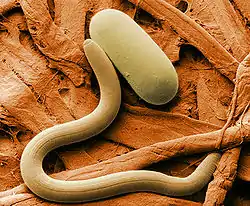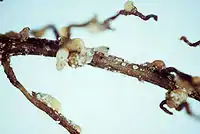Soybean cyst nematode
The soybean cyst nematode (SCN), Heterodera glycines, is the most devastating pest to crop yields in the U.S.,[5] targeting the roots of soybean and other legume plants. When infection is severe SCNs cause stunting, yellowing, impaired canopy development, and yield loss.[4] The symptoms caused by SCNs can go easily unrecognized by farmers. Due to the slight stunting and yellowing, many farmers may mistake these symptoms as environmental problems when in fact they are SCNs.[2] Due to the fact that soybean cyst nematodes can only move a few centimeters in the soil by themselves, they mostly are spread via tillage or plant transplants. This area of infection will look patchy and nonuniform making diagnosis more difficult for farmers.[4] They can be seen in the roots of summer soybean plants if the roots are taken out very carefully and gently washed with water. The egg masses should be seen as bright white or yellow “pearls” on the roots. The later the roots are pulled the harder it will be to diagnose due to the SCNs female dying and turning a much darker color, forming a “cyst”.[6] The best way to know if a field is infected by soybean cyst nematodes is to take a soil sample to a nematologist.
| Soybean cyst nematode | |
|---|---|
 | |
| Soybean cyst nematode and egg | |
| Scientific classification | |
| Kingdom: | Animalia |
| Phylum: | Nematoda |
| Order: | Tylenchida |
| Family: | Heteroderidae |
| Genus: | Heterodera |
| Species: | H. glycines |
| Binomial name | |
| Heterodera glycines Ichinohe, 1952 | |
Biology
As the nematode feeds, it swells. The female swells so much that her posterior end bursts out of the root and she becomes visible to the naked eye. In contrast, the adult male regains a wormlike shape, and he leaves the root in order to find and fertilize the large females. The female continues to feed as she lays 200 to 400 eggs in a yellow gelatinous matrix, forming an egg sac which remains inside her. She then dies and her cuticle hardens forming a cyst. The eggs may hatch when conditions in the soil are favorable, the larvae developing inside the cyst and the biological cycle repeating itself. There are usually three generations in the year. In the autumn or in unfavorable conditions, the cysts containing dormant larvae may remain intact in the soil for several years.[1] Although soybean is the primary host of SCN, other legumes can also serve as hosts.

Disease Cycle
Soybean cyst nematodes are so devastating due to their life cycle being so efficient for multiplication. They have 6 life stages, which is the norm for all nematodes. These stages include: egg, juvenile (J1-J4), and adult and can complete multiple cycles within a single growing season.[2] The SCNs makes its first molt while still inside the egg going from a juvenile 1 (J1) to a juvenile 2 (J2). When the soybean cyst nematode is a J2 it may then enter the root of the plant, usually just behind the root tip.[3] Once the SCNs has gained entry into the root, it will then create a specialized feeding cell called a syncytium by penetrating the pericycle, endodermis, or cortex cell with its stylet in order to take in nutrients from the plant.[3] These are cell masses with multiple nuclei that are formed due to cell wall dissolution and fusion. The J2 will then continue on in its development only when a syncytium cell is created.[6] Female SCNs will remain there for the rest of their life, while males will leave the root after reaching adulthood. The males are attracted to a pheromone that is released by the female when her egg mass is ready for fertilization. When the eggs from the egg mass are fertilized, some of them will hatch within that same growing year to continue on with infection.[3] Eggs will still remain inside the female, and when she dies and hardens into a “cyst”, they will go into dormancy until the following growing season or until conditions are favorable.[3] This cyst is very resilient against environmental conditions and can hold as many as 250 eggs.[6]
Locations
- Africa: Egypt
- Asia: Iran (Golestan Province and Mazandaran Province), China (Hebei, Hubei, Heilongjiang, Henan, Jiangsu, Liaoning), Indonesia (Java), Korean peninsula, Japan, Taiwan (unconfirmed), Russia (Amur District in the Far East).
- North America: Canada (Ontario), USA (Alabama, Arkansas, Delaware, Florida, Georgia, Illinois, Indiana, Iowa, Kansas, Kentucky, Louisiana, Maryland, Minnesota, Michigan, Mississippi, Missouri, Nebraska, New Jersey, North Carolina, North Dakota, Ohio, Oklahoma, Pennsylvania, South Carolina, South Dakota, Tennessee, Texas, Virginia and Wisconsin).
- South America: Argentina (unconfirmed), Brazil (unconfirmed), Chile, Colombia, Ecuador.
Management
Management of soybean cyst nematodes can be very difficult. Due to symptoms being hard to spot early on, they can infect a field rather quickly and persist indefinitely. SCNs can survive in the soil for long periods of time under adverse conditions, can work up on infecting previously resistant varieties of plants, and can never be completely eliminated (only suppressed).[5] For these reasons SCNs is a very economically devastating pest. SCNs cause up to $1.3 billion in annual losses due to their resilience and persistence in the soil. Soybean cyst nematodes can easily be prevented by thoroughly cleaning farm equipment to prevent introduction to the field.[6] If a field is already infected on the other hand, that won’t do much except help contain the infection from spreading to other fields. Right now, the most effective way of management is reducing tillage, planting resistant varieties, and crop rotation. [6] Reducing tillage will help isolate the SCNs into just the infected area because they are small and do not travel very far. SCNs in the cyst form will have about 50% of their eggs hatch each year so numbers can be greatly reduced if they do not have a host to infect for several years.[6] Planting resistant cultivars, rotating crops from soybean to corn, and planting cover crops are very effective management strategies to reduce the SCN population in a field. Studies have been done on using fungal root endophytes, such as fusarium, in deterring against nematodes which could be the next step in SCN prevention.[7]
Notes
References
2. Davis, E.L. and G.L. Tylka. 2000. Soybean cyst nematode disease. The Plant Health Instructor. doi:10.1094/PHI-I-2000-0725-01
- Masonbrink, R. et al. 2019. The genome of the soybean cyst nematode (Heterodera glycines) reveals complex patterns of duplications involved in the evolution of parasitism genes. BMC Genomics
- Tylka, G. 1995. Soybean cyst nematode. Iowa State University, University Extension
3. Iowa State University Integrated Crop Management https://crops.extension.iastate.edu/soybean/diseases_SCNbiology.html
4. University of Minnesota Extension https://extension.umn.edu/soybean-pest-management/soybean-cyst-nematode-management-guide#scn-damage-and-symptoms-1496262
5. Wrather, Allen and Mitchum, Melissa. Division of Plant Sciences. University of Missouri Extension https://extension.missouri.edu/publications/g4450
6. Dorrance, A., Martin, D., Harrison, K., Lopez-Nicora, H., and Niblack, T. Department of Plant Pathology. Ohio State university Extension https://ohioline.osu.edu/factsheet/plpath-soy-5
7. Strom, N., Hu, W., Harrith D., Chen S., & Bushley K. (2020). Corn and Soybean Host Root Endophytic Fungi with Toxicity Toward the Soybean Cyst Nematode. Journal of Phytopathology.
External links
- Species Profile - Soybean Cyst Nematode (Heterodera glycines), National Invasive Species Information Center, United States National Agricultural Library. Lists general information and resources for Soybean Cyst Nematode.
